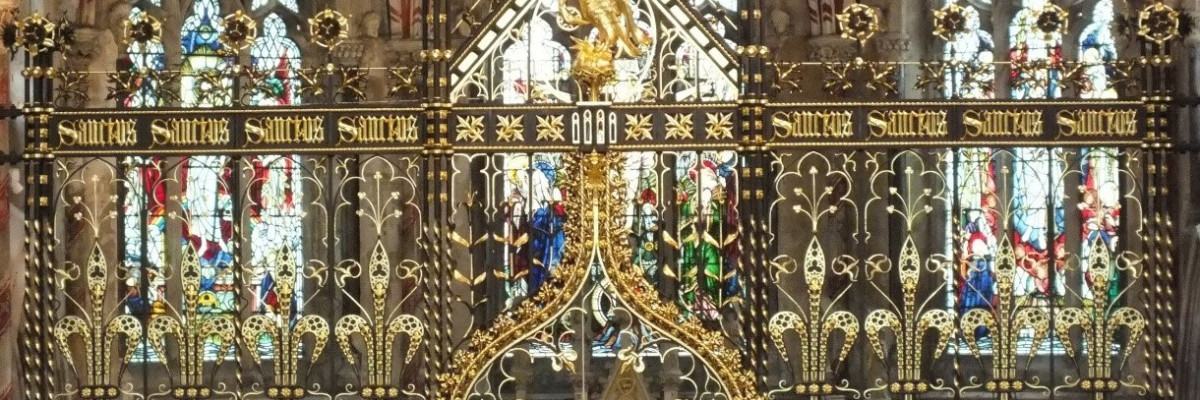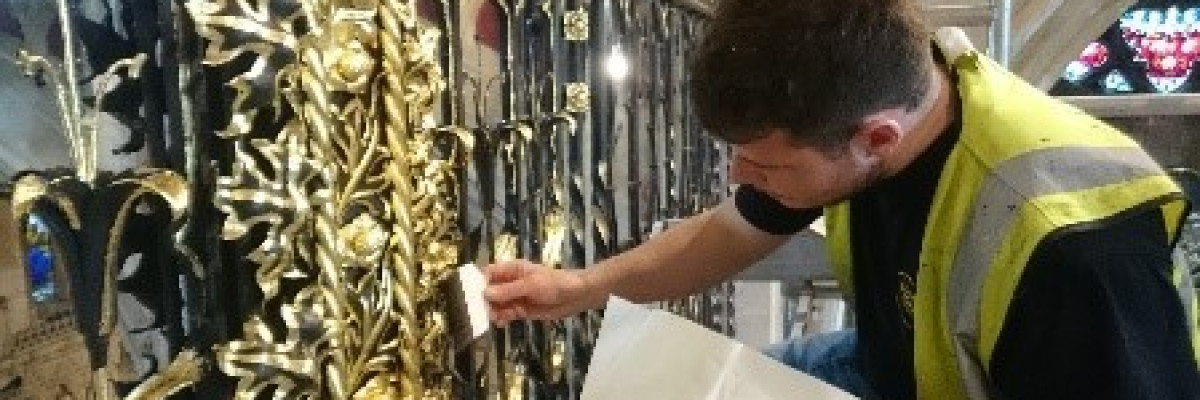St John's Church, rood screen
The word rood is derived from the Saxon word rood, meaning "cross". The rood screen is so called because it was surmounted by the Rood itself, which is a large figure of the crucified Christ supported on either side by statues of Mary and St John the Baptist Crucifixion.
Description of ironwork
The wrought iron screen at St John's church in Bath stands approximately 14 meters high and 6 meters wide, and was in need of re-gilding to bring it back to its original glory. and Dorothea Restorations was contracted to carry out these restoration works. The wrought iron screen itself was sound, but gilding had dulled over time and had worn away in places where hands had touched it or it had become scratched it where it had been knocked.
Work Carried out
A small team of 4 craftspeople worked for over 300 hours bringing it back to it magnificent splendour and now stands resplendent in its gold and black beauty before the nave of the church and shines out to all corners.
Gilding is not a new or modern craft. In fact, as early as 2300 B.C.E., the Egyptians used gold leaf to adorn wood and metal. Traditional methods are still used today.
What approach was taken and why
First, we prepared the surface, making sure is clean, dry and free from grease. We remove any defects, rust or flaky paint and residue. We cleaned with distilled water and allowed it to dry, then a single coat of Gilders size was applied with a thin and even coat. We used a mixture of sizes a traditional Charbonnel 3-hour size and a Vinyl Acrylic Copolymer alternative Wunda size, in different areas, periodically checking their drying condition. Why did we use of the different sizes? This approach was assessed for reducing our staff to exposure to a hazardous product with its associated health implications. The traditional size does, however, have a drying time, so we chose to use this on the lower level of the screen, where the gilding could be touched or knocked. The longer you can wait, the better the finish - although if it dries completely, you will be back to square one. The size should be ready around 30 minutes before complete drying, when the size has just a little tack to it, then you're ready to gild. On the high area of the screen, where most of the gilded areas were, we used the Wunda size. This product does not have a final drying time but only goes to the tack stage this gives a much longer working time, but can be less stable, this being the reason to use the product at a higher height. The lower risk of health issues to our staff means it is a much better product to use, where possible.
Gold is the most popular and beautiful metal that exists. It is produced in leaf form, which is available in a range of carts and comes in books. The leaf is taken from the book and transferred onto your pad, where you will cut it to the size you require. It is then transferred from your pad to a traditional squirrel hair tip. Placing a leaf of gold onto the gilder's pad can be quite tricky at first. The thin and light nature of the gold means that the smallest draught of air (even breath) can blow the gold of the pad and away from you. Any quick movements, draughts and heavy breathing will cause the gold to fly off the pad. The next step is to pick a piece up with the gilder's squirrel tip and apply it to the area that has been sized, careful not to let any of the hairs on the gilder's tip touch the size. When the working area is covered in gold, it is time to skew it. This involves lightly brushing a squirrel hair gilder's mop over the surface to remove any excess gold. The generosity of overlapping pays off here because this process will also push the excess flakes into the crevices and hollows of the piece and will fill in any gaps in the work. This is done in a light circular motion. Again, taking care that the bristles do not come out of the brush and stick to the size. Then you move on to the next area, working out how much surface area you are able to cover in your day is key to a good workflow. Temperature and air flow all have a bearing on your working time.
Back to case studies





